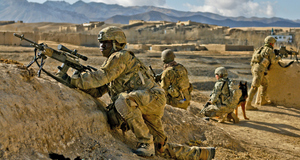From Nostalgia to Post-Traumatic Stress Disorder: A Mass Society Theory of Psychological Reactions to Combat
By
2013, Vol. 5 No. 02 | pg. 3/3 | « The late historian and former World War Two-era Army platoon commander, Paul Fussell (1989), explained that “the allied war has been sanitized and romanticized almost beyond recognition” particularly because it is commonly viewed as a just war (p. ix). Importantly, these stories significantly influence how observers regard veterans of these conflicts. What is particularly shocking about the lack of knowledge concerning combat stress in the Second World War is that it was so incredibly rampant, yet almost comprehensively ignored. Most famously, during his visit to a field hospital in Sicily in 1943, U.S. Army General George S. Patton slapped a young soldier who had been hospitalized for battle fatigue. Thereafter, Patton is reported to have proclaimed “I won’t have the hospitals cluttered up with these sons of bitches who haven’t got the guts to fight. Send that yellow son of a bitch back to the front line.” This brand of machismo and disregard for troop welfare led to numerous afflicted servicemen having “lack of intestinal fortitude” annotated in their military service records (Gandolfini, 2010). According to Bentley (2005), of the roughly 800,000 soldiers who actually saw combat during WWII, 37.5% displayed such severe symptoms of combat stress that they were permanently discharged; which is an absolutely staggering statistic. In the U.S. Army alone (not including the Air Corps) over 500,000 men were removed from the front indefinitely and nearly 1.4 million more temporarily for psychiatric reasons. As it was difficult to believe that so many of the Greatest Generation were encumbered by “weak” characters, the military adopted the practice of employing sterilized euphemistic language and stopped questioning individual fortitude.Consequently, the condition was referred to as “battle fatigue.” By the time that the United States intervened in Korea, the humanity of combat stress had been almost completely removed and its perceived seriousness diminished. Those displaying symptoms of traumatic reactions were said to have suffered from “operational exhaustion,” which further distanced observers from the reality of the disorder. Of the nearly 200,000 soldiers who saw combat during the Korean War, nearly one-quarter were classified as psychiatric casualties. No More VietnamsIt is no longer a topic of debate that the fighting during the Vietnam War was demonstrably more intense than was experienced in previous American conflicts; largely due to the mobility of the helicopter which kept troops almost perpetually embattled. Unfortunately, as asserted by former President Richard Nixon, the Vietnam War “was misreported then, and it is misremembered now” (Nixon, 1985, p. 9). The conflict and the men who fought it remain among the most misunderstood in American history. From the outset of the Vietnam War, the military employed various preventive measures to decrease the number of psychological casualties, such as providing every battalion with medical staff trained in the identification and treatment of specific mental health problems. In the initial years of the war, these protocols appeared to be largely successful. However, this was a new kind of conflict. Americans were not only fighting the North Vietnamese Army (NVA), but the mostly unidentified Viet Cong (VC) as well. Undoubtedly, the notion of an unknown enemy was particularly taxing on their psychological well-being. Moreover, soldiers in Vietnam were the first to be given a date of expected return from overseas (DEROS). This alone hindered the development of the usual buffers against combat stress, such as unit cohesion. One-year individual tours prevented many troops from feeling as if they were truly part of something larger than themselves and hampered group morale. As the war progressed and the public began to question its legitimacy, instances of combat reaction increased (Bentley, 2005). This was the first time in American history that many citizens welcomed their veterans as murderers rather than heroes. Veterans returning from the campaign who displayed symptoms of psychological trauma were said to be suffering from Post-Vietnam Syndrome, which consisted of combat-related nightmares, depression, alcohol and drug dependence, and/or anxiety. However, the malady was not recognized by the APA and the U.S. Government contended that it was merely a “transient situational disorder”; hence regarded as a pre-existing condition and not eligible for treatment or compensation through the Department of Veterans Affairs (VA). In 1979, eight long years after it was initially proposed, having been killed and reincarnated several times, Senator Alan Cranston’s bill which called for the establishment of outreach centers for Vietnam veterans suffering from service-related psychological problems was passed by Congress. It wasn’t until the following year that Post-Traumatic Stress Disorder was finally recognized by the mental health community in the Diagnostic and Statistical Manual of Mental Disorders Version III. Factual estimates of the prevalence of combat stress reactions vary, but the oft-cited National Vietnam Veterans’ Readjustment Study, conducted by Congressional mandate in 1983, concluded that nearly one-third of Vietnam veterans have had PTSD at some point in their lives and that some 830,000 suffered from PTSD at the time of the study. However, only about 55,000 had filed relevant disability claims; roughly half of which had been upheld by adjudication boards (Price, 2007). Summary and ConclusionsThough its name has changed over the ages, the construct known since 1980 as Post-Traumatic Stress Disorder has been documented since scholars first sought to explain human behavior. Medical professionals spent centuries haphazardly seeking the underlying causes of the condition, but were ultimately limited by their physiological model of medicine until the emergence of psychoanalysis. The place-holders used to describe the disorder were merely physicians’ attempts to create broadly descriptive syndromes based upon unreliable self reports and confused causation. As in the time of the Ships of Fools, sane men have had difficulty accepting that not much separates them from madness. Following the Vietnam War and the belated acceptance of Post-Traumatic Stress Disorder as a legitimate disability, the public appears to have agreed with the use of their tax dollars to treat veterans suffering from PTSD. However, weakening solidarity has served to shift the responsibility for treatment to the bureaucracy of government. Ostensibly, Americans do not necessarily feel that veterans are literally fighting for them or their individual freedoms. Rather, they defend a more abstract concept of national interest which may or may not have anything to do with the observer. In a society wherein so few choose to serve, veterans are susceptible to stigmatization due to a lack of understanding of their experiences. It may be difficult for someone to relate to a particular issue if he or she does not personally know anyone connected to it. Ergo, public ignorance can prompt myths concerning the stability and worthiness of veterans as well as erect social barriers toward seeking professional assistance. This is becoming especially true as the United States has remained almost perpetually at war or in preparation for one since at least the early 1900s. Under such circumstances, those who do not actually participate in the conflict may become detached from the media sound bites as the live feed of explosions in some distant land becomes business as usual. Much like Fussell’s aforementioned analysis of the Second World War, the current War on Terror has been romanticized. The role formerly filled by John Wayne in his Kevlar helmet with unbuckled chinstrap is being assumed by young chiseled men in countless films. This provides a completely skewed idea of what war is and how it affects the human mind. Where advancements in transportation and social welfare reform prompted dramatic changes in how those suffering from combat stress in the 19th Century were perceived, mass communications continue to detach citizens from the reality of Post-Traumatic Stress Disorder. ReferencesAmerican Psychiatric Association. (2000). Diagnostic and statistical manual of mental disorders (Revised 4th ed.). Washington, DC: Author. BBC. (2006, August 16). Shot at dawn, pardoned 90 years on. Retrieved from http://news.bbc.co.uk/2/hi/uk_news/england/4798025.stm Bell, D. (1956). The theory of mass society. Commentary, 22(1), 75-83. Bentley, S. (2005). A short history of PTSD: From Thermopylae to Hue soldiers have always had a disturbing reaction to war. Retrieved from http://www.vva.org/archive/TheVeteran/2005_03/feature_HistoryPTSD.htm Catherall, D. R. (1986). The support system and amelioration of PTSD in Vietnam veterans. Psychotherapy: Theory, Research, Practice, Training, 23(3), 472-482. Charvat, M. (2010). History of Post-traumatic Stress Disorder in combat [PowerPoint slides]. Retrieved from http://www.warrelatedillness.va.gov/WARRELATEDILLNESS/education/conferences/2010-sept/slides/2010_09_14_CharvatM-History-of-PTSD-in-Combat.ppt Davids, T. W. R. (1880). Buddhist birth stories; or Jataka tales. The oldest collection of folk-lore extant: Being the Jatakatthavannana. Boston, MA: Houghton, Miffin, & Co. Department of Veterans Affairs. (2004). VA fact sheet: World War II veterans by the numbers. Washington, DC: Author. Dickens, C. (1880 / 2008). The letters of Charles Dickens – Vol. 2, 1857-1870. London, UK: Chapman & Hall. Foucalt, M. (1965). Madness and civilization: A history of insanity in the age of reason. (R. Howard, Trans.). New York, NY: Random House. (Original work published 1961). Fussell, P. (1989). Wartime: Understanding and behavior in the Second World War. New York, NY: Oxford University Press. Gabriel, R. A. (1987). No more heroes: Madness and psychiatry in war. New York, NY: Macmillan. Gandolfini, J. (Producer), Alpert, J., Goosenberg-Kent, E., & O’Neill, M. (Directors). (2010). Wartorn: 1861-2010 [Motion picture]. United States: Home Box Office. Grossman, D. (2000). On sheep, wolves and sheepdogs. Retrieved from http://www.killology.com/sheep_dog.htm Hamblen, J. (2009). PTSD 101 Courses: What is PTSD? [Adobe Flash presentation]. Retrieved from http://www.ptsd.va.gov/professional/ptsd101/course-modules/what-is-ptsd.asp Harper, C. L. & Leicht, K. T. (2011). Exploring social change: American and the world (6th ed.). Upper Saddle River, NJ: Pearson Prentice Hall. Haughn, C. & Gonsiorek, J. C. (2009). The Book of Job: Implications for construct validity of posttraumatic stress disorder diagnostic criteria. Mental Health, Religion & Culture, 12(8), 833-845. Homer. (1998). The iliad. (R. Fagles, Trans.). New York, NY: Penguin Classics. (Original work published 730 BCE). Jayatunge, R. M. (2012). Post-Traumatic Stress Disorder (PTSD) – A malady shared by east and west [PowerPoint slides]. Retrieved from http://fmso.leavenworth.army.mil/Collaboration/international/Sri%20Lanka/PTSD.pdf Jung, C. G. (2010). Answer to Job. (R. F. C. Hull, Trans.). Princeton, NJ: Princeton University Press. (Original work published 1952). Kaeuper, R. W., & Kennedy, E. (Eds.). (1996). The book of chivalry of Geoffroi de Charny: Text, context, and translation. Philadelphia, PA: University of Pennsylvania Press. Mitchell, T. J. (2010). History of the Great War based on official documents: Medical services, casualties and medical statistics. Uckfield, UK: Naval and Military Press. Mokros, A., Menner, B., Eisenbarth, H., Alpers, G. W., Lange, K. W., & Osterheider, M. (2008). Diminished cooperativeness of psychopaths in a prisoner’s dilemma game yields higher rewards. The Journal of Abnormal Psychology, 117(2), 406-413. doi:10.1037/0021-843X.117.2.406 Nixon, R. (1985). No more Vietnams. New York, NY: Arbor House. Price, J. L. (2007). Findings from the National Vietnam Veterans’ Readjustment Study. Retrieved from http://www.ptsd.va.gov/professional/pages/vietnam-vets-study.asp Rosen, G. (Ed.). (2004). Posttraumatic Stress Disorder: Issues and controversies. Indianapolis, IN: Wiley. Sayer, N.A., Friedmann-Sanchez, G., Spoont, M., Murdock, M., Parker, L.E., Chiros, C., & Rosenheck, R. (2009). A qualitative study of determinants of PTSD treatment initiation in veterans. Psychiatry, 72(3), 238-255. Shakespeare, W. (1597 / 2010). King Henry IV, part 1. Fairfield, IA: Akasha Publishing. Shakespeare, W. (1603 / 1993). Macbeth. Mineola, NY: Dover Publications. Trimble, M.D. (1985). Post-Traumatic Stress Disorder: History of a concept. In C.R. Figley (Ed.), Trauma and its wake: The study and treatment of Post-Traumatic Stress Disorder. New York, NY: Brunner/Mazel. Revised from Encyclopedia of Psychology, R. Corsini, Ed. (New York, NY: Wiley, 1984, 1994). Van der Kolk, B. A., Brown, P., & Van der Hart, O. (1989). Pierre Janet on post-traumatic stress. Journal of Traumatic Stress, 2(4), 365-378. Suggested Reading from Inquiries Journal
Inquiries Journal provides undergraduate and graduate students around the world a platform for the wide dissemination of academic work over a range of core disciplines. Representing the work of students from hundreds of institutions around the globe, Inquiries Journal's large database of academic articles is completely free. Learn more | Blog | Submit Latest in Sociology |
















